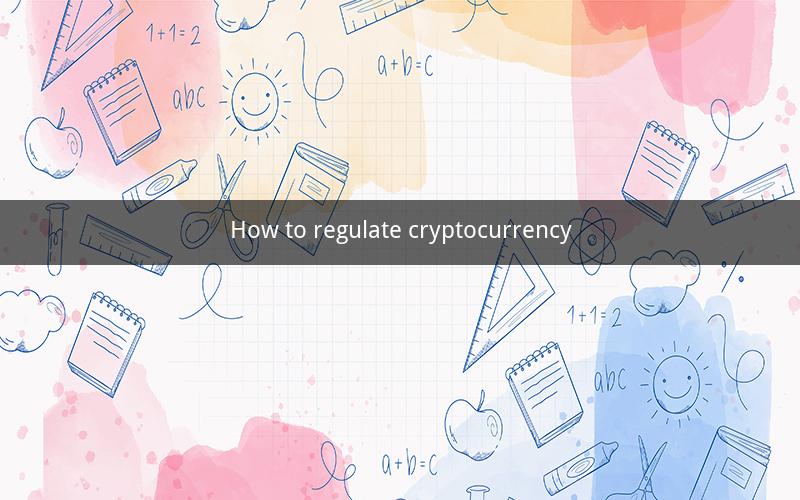
Table of Contents
1. Introduction to Cryptocurrency Regulation
2. The Importance of Cryptocurrency Regulation
3. Current Cryptocurrency Regulations Around the World
4. Challenges in Cryptocurrency Regulation
5. Strategies for Effective Cryptocurrency Regulation
6. Conclusion
1. Introduction to Cryptocurrency Regulation
Cryptocurrency, a digital or virtual form of currency, has gained immense popularity in recent years. However, the rapid growth and innovation in this field have raised concerns regarding its regulation. This article aims to provide an overview of cryptocurrency regulation, highlighting its importance, current regulations, challenges, and strategies for effective regulation.
2. The Importance of Cryptocurrency Regulation
Regulating cryptocurrency is crucial for several reasons. Firstly, it helps protect investors from fraudulent schemes and scams. Secondly, it ensures compliance with anti-money laundering (AML) and know-your-customer (KYC) requirements, thereby reducing the risk of financial crimes. Additionally, it promotes stability in the financial system and enhances consumer trust in cryptocurrencies.
3. Current Cryptocurrency Regulations Around the World
The approach to cryptocurrency regulation varies across different countries. Some countries have implemented strict regulations, while others have taken a more lenient stance. Here's a brief overview of the current regulations in some key regions:
- United States: The U.S. has no comprehensive federal regulation for cryptocurrencies. However, various agencies, including the Securities and Exchange Commission (SEC), the Commodity Futures Trading Commission (CFTC), and the Financial Crimes Enforcement Network (FinCEN), have jurisdiction over different aspects of cryptocurrency regulation.
- Europe: The European Union has adopted the Markets in Crypto-Assets (MiCA) regulation, which aims to provide a comprehensive regulatory framework for crypto-assets. The MiCA regulation covers areas such as licensing requirements, transparency, and consumer protection.
- Asia: Japan and South Korea have been at the forefront of cryptocurrency regulation. Japan has implemented strict regulations, while South Korea has taken a more balanced approach.
4. Challenges in Cryptocurrency Regulation
Regulating cryptocurrency poses several challenges. Firstly, the decentralized nature of cryptocurrencies makes it difficult to track and regulate transactions. Secondly, the rapidly evolving technology and emerging use cases of cryptocurrencies create new challenges for regulators. Lastly, the global nature of cryptocurrency means that regulations must be harmonized across countries to be effective.
5. Strategies for Effective Cryptocurrency Regulation
To effectively regulate cryptocurrency, regulators can consider the following strategies:
- Harmonization of regulations: Collaboration between countries is essential to ensure consistency in regulations. This can help prevent regulatory arbitrage and enhance the effectiveness of regulations.
- Education and awareness: Educating the public about the risks and benefits of cryptocurrencies is crucial. This can help individuals make informed decisions and reduce the risk of scams.
- Technological innovation: Utilizing blockchain and other emerging technologies can help regulators track transactions and monitor compliance with regulations.
- Flexibility: Regulations should be flexible enough to adapt to the evolving nature of cryptocurrencies. This can help prevent unnecessary restrictions on innovation.
6. Conclusion
Cryptocurrency regulation is a complex and evolving field. However, with a clear understanding of the challenges and strategies for effective regulation, governments can create a conducive environment for the growth and development of the cryptocurrency industry.
---
Questions and Answers
1. What is the primary objective of cryptocurrency regulation?
- To protect investors, prevent financial crimes, and ensure compliance with anti-money laundering and know-your-customer requirements.
2. Why is the decentralized nature of cryptocurrencies challenging for regulators?
- It makes it difficult to track and regulate transactions, as well as enforce regulations.
3. What is the MiCA regulation, and how does it differ from other cryptocurrency regulations?
- The MiCA regulation is a comprehensive regulatory framework for crypto-assets adopted by the European Union. It aims to provide a clear and consistent regulatory environment for crypto-assets across the EU.
4. What is the role of the Securities and Exchange Commission (SEC) in cryptocurrency regulation?
- The SEC has jurisdiction over various aspects of cryptocurrency regulation, including the classification of cryptocurrencies as securities and enforcement actions against fraudulent schemes.
5. How can education and awareness help in regulating cryptocurrencies?
- By educating the public about the risks and benefits of cryptocurrencies, individuals can make informed decisions and reduce the risk of scams.
6. What are some of the emerging technologies that can help in regulating cryptocurrencies?
- Blockchain technology and artificial intelligence can help regulators track transactions, monitor compliance, and identify potential risks.
7. Why is collaboration between countries important in cryptocurrency regulation?
- To ensure consistency in regulations, prevent regulatory arbitrage, and enhance the effectiveness of regulations.
8. What is the potential impact of strict cryptocurrency regulation on innovation?
- It could hinder innovation and restrict the growth of the cryptocurrency industry.
9. How can regulators strike a balance between regulating cryptocurrencies and fostering innovation?
- By adopting flexible regulations that adapt to the evolving nature of cryptocurrencies while ensuring compliance with existing laws and regulations.
10. What is the future of cryptocurrency regulation?
- The future of cryptocurrency regulation will likely involve a combination of harmonized international regulations, technological innovation, and increased public awareness.